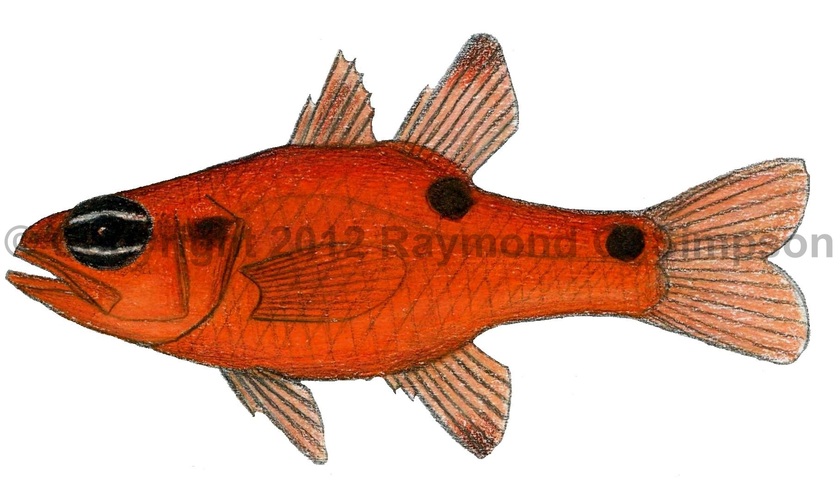
Common Name
Twospot Cardinalfish
Year Described
Longley, 1932
Identification
Dorsal Fin: VI, I-9
Anal Fin: II, 8
Pelvic Fin: I, 5
Pectoral Fin: 12
Gill Rakers: 4-5 upper, 12-14 lower
Vertebrae: 10 precaudal, 14-15 caudal
A small fish with a fairly robust and moderately compressed body. Eye is large and the snout short. Mouth is fairly large and oblique, with the lower jaw slightly protruding. Both jaws, palatine, and vomer with narrow bands of villiform teeth (no canines). Preopercular edge with a slightly serrate margin. Preopercular flap does not extend past the preopercular rear margin. There are two dorsal fins. The caudal fin is emarginate. Body scales ctenoid. Scales around the caudal peduncle 15-16.
Color
Body pale pink to bright red-orange (sometimes translucent). The eye is black with two white stripes. An eye-stripe of varying intensity is often present, with an round opercular blotch being most prominent. A dark spot smaller than eye is immediately under second dorsal fin. The caudal peduncle spot is slightly smaller than the first spot and is slightly off-center. The fins are pale pink.
Size
Maximum size to 110mm TL.
Habitat
Found on rocky reefs, artificial reefs, and coral reefs from 1-403m. Inhabits dark caves and recesses.
Range
Massachusetts to S. Brazil, including the Gulf of Mexico and the Caribbean Sea. Also Bermuda.
References
Gon, O. 2002. Apogonidae (pp 1386-1391). In: Carpenter. 2002. The living marine resources of the Western Central Atlantic. Vol. 3: Bony fishes part 2 (Opistognathidae to Molidae), sea turtles and sea mammals. FAO Species Identification Guides for Fisheries Purposes. American Society of Ichthyologists and Herpetologists Special Publication No. 5.
McEachran, J.D. & J.D. Fechhelm. 2005. Fishes of the Gulf of Mexico. Volume 2: Scorpaeniformes to Tetraodontiformes. University of Texas Press, Austin. i-viii +1-1004.